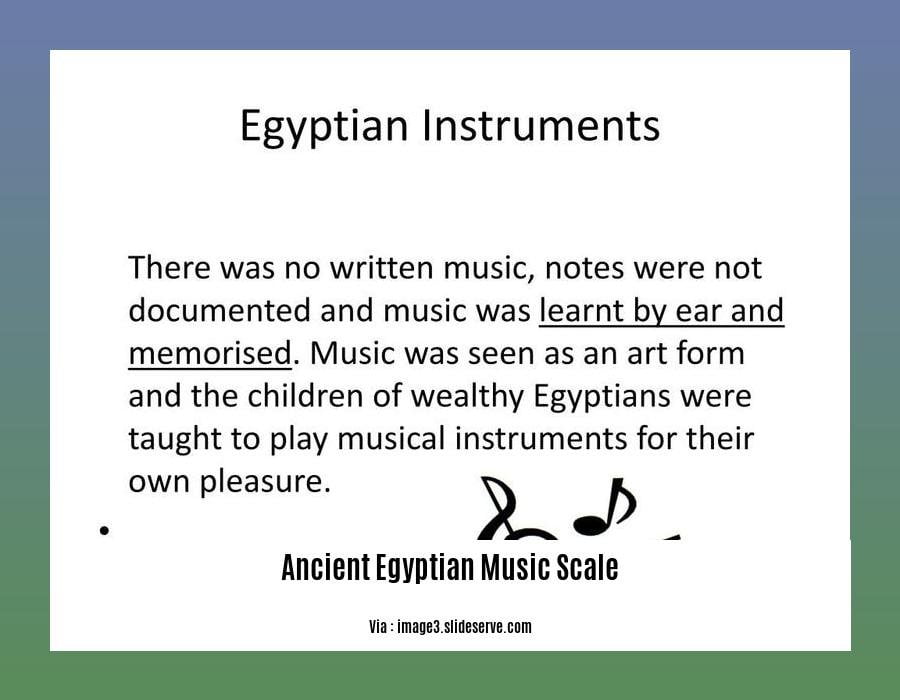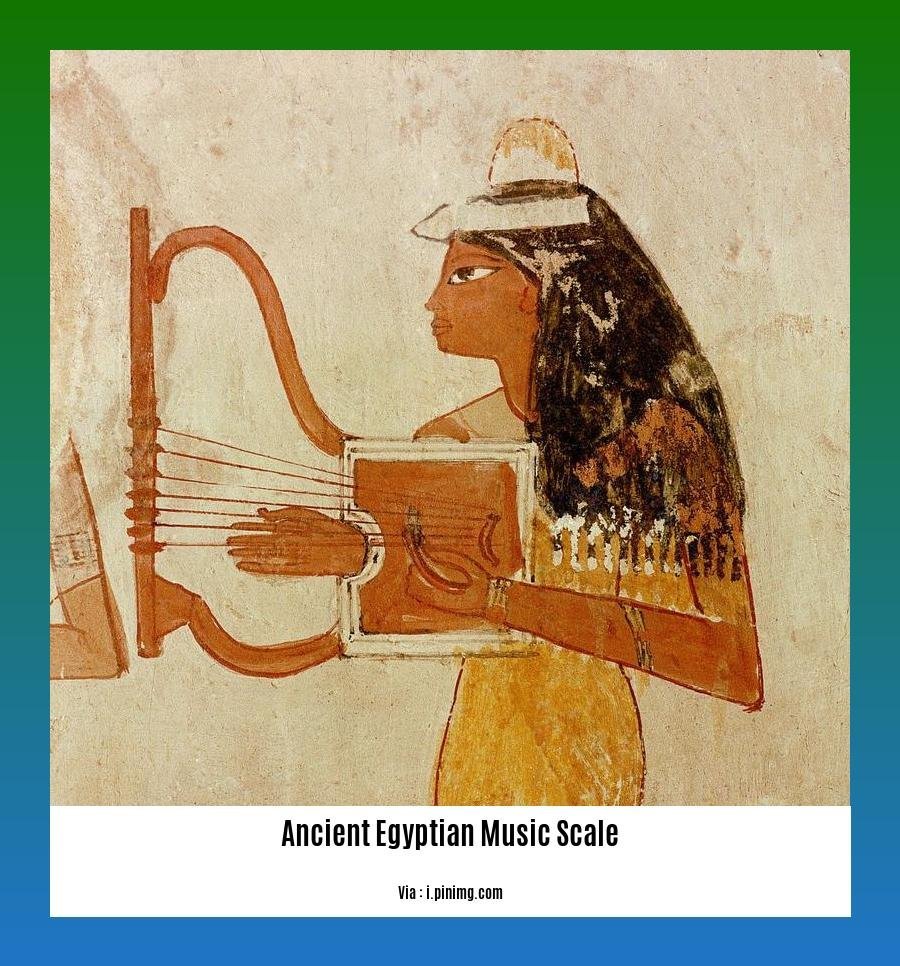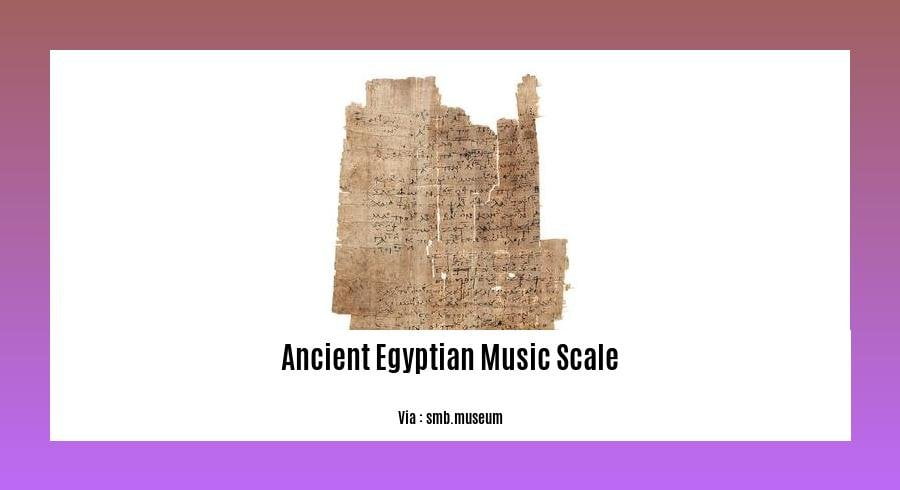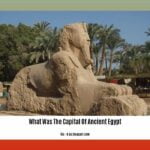Are you ready for a musical adventure through the sands of time? Let’s dive into the fascinating world of ancient Egyptian music! Researchers have been digging deep into Egypt’s secrets, and they’ve discovered how their scales rocked. Get ready to decode hieroglyphics, explore ancient instruments, and uncover the secrets behind the amazing sounds of this ancient civilization. The tunes that once filled the temples and pyramids are just waiting to be brought back to life!

Ancient Egyptian Music Scale
Imagine a world where music wasn’t just about entertainment but a way to connect with the universe itself. That’s what music was like for the ancient Egyptians. They didn’t just pluck strings or blow into reeds; they channeled the cosmos into sound.
Their music scale wasn’t quite like the ones we’re used to. Instead of the familiar seven notes, they likely used a five-note structure called a pentatonic scale. This probably gave their music a distinct flavor, full of mystery and echoing with something ancient and powerful.
It was more than just the number of notes. The ancient Egyptians believed that each note in their scale was linked to a specific celestial body. It wasn’t just sound; it was a reflection of the stars. Each note was represented by a hieroglyph, a symbol in their writing system, which further cemented the connection between music, the heavens, and their understanding of the world.
This deep connection between music and the cosmos suggests they saw music as more than just art. Some researchers believe that these specific sounds and rhythms may have been used for healing purposes. They suggest that by aligning themselves with the cosmic energies represented in the music, the ancient Egyptians could promote well-being and possibly even treat illnesses.
This idea of music as medicine might sound unusual today, but it was a common belief in many ancient cultures. Interestingly, the pentatonic scale wasn’t unique to Egypt. It pops up in various forms across the globe, from ancient China to the Celtic traditions of Ireland. This begs the question: could there be a shared musical root connecting these disparate cultures?
While we can’t say for sure how the ancient Egyptians used their music or what its full impact was, we can still appreciate its unique beauty and the fascinating worldview it represents. Looking at it through the lens of history and archaeology, we get a glimpse into a culture that saw music not just as entertainment, but as a fundamental force connecting them to the universe.
There’s still much we don’t know about the ancient Egyptian music scale. Ongoing research continues to uncover new insights into its structure, its meaning, and its potential applications. It’s a fascinating field of study with the potential to teach us not just about ancient music, but about the very way ancient civilizations understood the world around them.
Key Points of the Ancient Egyptian Music Scale:
- Pentatonic Scale: Used five notes instead of the seven in modern scales.
- Cosmic Connections: Each note may have represented a celestial body, linking music to the universe.
- Healing Properties: Music may have been believed to possess healing powers by aligning with cosmic energies.
- Hieroglyphic Representation: Notes were symbolized with hieroglyphs, further cementing the connection between music and the written word.
- Shared Roots: The pentatonic scale appears in various forms across different cultures, suggesting a possible shared musical origin.
- Historical and Archaeological Significance: Ongoing research reveals the structure, meaning, and applications of the ancient Egyptian music scale.
- Cultural Impact: Music was not just entertainment but a fundamental force connecting them to the cosmos.
Always dreamed of understanding the hieroglyphs lining the ancient temples of Egypt? Learn all about the linguistic history of the ancient Egyptians and explore their rich vocabulary in the extensive ancient Egyptian language dictionary.
Discover the secrets of the ancient Egyptian city planning by exploring the acclaimed works of visionary architects who designed iconic structures like the pyramids and temples.
Customize your character with names inspired by Ancient Egypt! The ancient Egyptian name generator offers authentic and unique names that bring the past to life.

What Scale is Egyptian Music Played On?
So, you’re curious about the sounds of ancient Egypt, huh? You’ve probably heard their music had a certain something to it, a unique flavor. Well, a big part of that comes down to the scale they used – think of it like the musical alphabet they were working with.
Now, unlike the scales we’re used to today with seven notes, the ancient Egyptians kept things a bit simpler. Their go-to was probably a pentatonic scale, meaning it had just five notes. Don’t let that fool you though, five notes in the right hands can make some seriously catchy tunes!
The exact intervals between these notes are what give the Egyptian scale its distinctive sound. We’re talking about the Root/Prime (1P), Major 2nd (2M), Perfect 4th (4P), Perfect 5th (5P), and Minor 7th (7m). Sounds complicated? Maybe a bit, but just know that this particular combination of notes creates a mood that’s both ancient and strangely familiar.
You see, this Egyptian scale bears a striking resemblance to the minor pentatonic scale that’s still super popular today. If you’ve ever tapped your foot to some blues, rock, or folk music, chances are you’ve swayed to the sounds of the minor pentatonic. And hey, it even pops up in traditional music from other parts of the world, like Africa and Asia. This little connection has led some music historians to believe these scales might share a common ancestor, way back in the mists of time. Talk about musical family reunions!
Back in ancient Egypt, music wasn’t just for fun, it was woven into the fabric of their lives. This pentatonic scale probably provided the soundtrack to everything from grand religious ceremonies and rituals to the everyday hustle and bustle of life. Imagine hearing those five notes echoing through the bustling marketplaces or accompanying the pharaohs on their journeys to the afterlife.
Of course, piecing together the intricacies of ancient music is no easy feat. Archaeologists and music historians are constantly digging up new clues that could change our understanding of Egyptian music. But for now, knowing they likely relied heavily on this five-note scale gives us a tantalizing glimpse into the soundscape of a long-gone civilization.
So, next time you hear anything with that minor pentatonic vibe, remember the ancient Egyptians who were rocking out to those same notes millennia ago. It’s a musical thread connecting us through time, proving that a good melody transcends cultures and centuries.
Key Lines:
- The Egyptian scale, a 5-note pentatonic scale, originated in ancient Egypt and has a distinct melodic style.
- Its intervals include a major 2nd, perfect 4th, perfect 5th, and minor 7th, resulting in a unique harmonic structure.
- The Egyptian scale bears striking similarities to the minor pentatonic scale used in modern music.
- Its influence can be traced throughout ancient Egyptian music, permeating religious rituals, ceremonies, and daily life.
What is the Egyptian Key Scale?
Imagine listening to music in ancient Egypt. It wasn’t just something to tap your feet to—it was a direct link to the gods! Music held immense power in their culture. And at the heart of their music was this really cool scale called the Egyptian key scale. It’s had scholars scratching their heads for ages, trying to unlock its secrets.
So, what makes it so special? Well, unlike the scales we’re used to hearing today, which usually have seven notes, the Egyptian key scale is likely a pentatonic scale. That means it only uses five notes. These five notes work together in a super unique way to create these melodies that sound mysterious and almost magical.
Think about the spaces between the notes in a scale – musicians call those spaces intervals. The Egyptian scale’s intervals are like its secret sauce. They’re different from any other pentatonic scale, which explains why it has that signature sound. You’ll hear a major second, a minor third, a perfect fourth, and a major sixth. That minor third, in particular, adds this cool, almost haunting vibe to the melodies.
The Egyptian key scale hasn’t just stayed tucked away in ancient history, though. You can actually hear its influence in music across time periods! From those ancient Egyptian hymns they used to chant to, believe it or not, some modern film scores! Composers love using it when they want to create a sense of history, mystery, or something a little “otherworldly.” Ever seen “The Mummy” or “Aladdin”? Yep, the Egyptian scale is probably in those soundtracks, adding to the whole atmosphere of those movies.
Here’s the thing: We don’t have recordings of ancient Egyptian music lying around. Can you imagine? We’re piecing together what we know about the Egyptian key scale from what historians and musicians have been able to figure out from the evidence we do have. There’s still a lot we don’t know for sure, which makes it even more fascinating to explore!
Key Lines:
- The ancient Egyptian music scale is likely a pentatonic scale, meaning it consists of five tones.
- The Egyptian scale is the 2nd mode of the major pentatonic scale.
- The Egyptian scale’s intervals are unique and distinct from other pentatonic scales.
- The Egyptian scale has been used in modern music to create a sense of mystery and exoticism.
What Was the Scale Used for in Ancient Egypt?
Picking up from where we left off, let’s talk about the music of ancient Egypt! Imagine the melodies echoing through grand temples and bustling marketplaces—it was a vital part of their lives, weaving its way into everything from sacred rituals to everyday moments.
Now, you might be wondering, what did this ancient music actually sound like? Well, the Egyptians likely had their own special scale, different from the ones we’re used to hearing today. They probably used something called a “pentatonic scale,” which basically means it had five notes.
Think of it like this: instead of playing all the white keys on a piano, imagine playing just five specific ones. The Egyptians may have chosen D, E, F#, G, and A. This created a really distinct sound, something you might even call “exotic” to our modern ears.
One of the things that makes the Egyptian scale so unique is the use of “augmented seconds.” Don’t worry too much about the technical jargon, but just know it gives the music a kind of spacious, almost “oriental” feeling.
And guess what? This ancient scale wasn’t just a passing fad! It’s been passed down through the ages, inspiring musicians from all walks of life. We’re talking everyone from, well, ancient Egyptian priests, to 20th-century jazz musicians! It’s amazing how music can connect us across time like that.
The Egyptian scale has this incredible ability to transport you back in time. When you hear it, you almost feel like you’re right there with the pharaohs!
Here’s a quick recap of what makes this ancient scale so cool:
- Five Notes: D, E, F#, G, and A
- Unique Sound: Thanks to those augmented seconds, we get that “oriental” vibe.
- Music for All Occasions: From religious ceremonies to just hanging out, music with this scale was everywhere in ancient Egypt.
- Timeless Inspiration: This ancient scale still influences musicians today—talk about a lasting legacy!
We’re still learning new things about ancient Egyptian music all the time. Who knows what other musical mysteries are waiting to be uncovered? It’s an exciting field of study!
Key Lines:
- The Egyptian Scale is a pentatonic scale, consisting of five notes: D, E, F#, G, and A.
- This scale is characterized by its use of intervals that sound distinctly non-Western to modern ears.
- The Egyptian Scale has been used in various forms by musicians throughout history, from the ancient Egyptians to 20th-century jazz musicians.
- The scale creates a unique and evocative sound that transports listeners back to the time of the pharaohs.
What is the Scale in Egyptian Mythology?
Picking up where we left off, let’s delve deeper into this captivating musical system. We already know that ancient Egyptians held music in high regard, believing it to be a divine gift. Their unique approach to music, specifically their use of a pentatonic scale, wasn’t just about creating beautiful melodies; it was deeply intertwined with their spiritual beliefs and artistic expressions.
Imagine a scale that uses only five notes. That’s the basic idea behind a pentatonic scale. It might sound simple, but ancient Egyptians may have used it to create music that was both distinctive and deeply meaningful to them.
But what made this scale so special? Well, each of these five notes may have been carefully chosen to correspond to celestial bodies within their cosmology. Think of it like this: every time they played a note, they weren’t just hearing a sound, they were connecting with the cosmos.
Adding to the intrigue, the intervals – the spaces between the notes – were carefully selected. This resulted in a sound that was both mysterious and otherworldly. Imagine hearing a major 2nd, a perfect 4th, a perfect 5th, and a minor 7th all woven together. It creates a sonic tapestry that’s quite different from the musical scales we’re familiar with today.
Now, you can’t talk about ancient Egypt without mentioning the Scales of Ma’at. This powerful symbol represented the weighing of hearts against the feather of truth in the afterlife. It signified the paramount importance of balance and justice in their society. Interestingly, the scales were often depicted alongside what might have been the Egyptian musical scale, further emphasizing the profound link between music, morality, and the divine.
What’s truly amazing is how the Egyptian scale continues to capture the imagination of people today. Even though its roots lie in an ancient civilization, its melodies still resonate with modern listeners. It’s like a sonic bridge connecting us to the past.
Contemporary musicians and composers have found ways to incorporate this ancient scale into their own work, blending it with everything from electronic music and ambient soundscapes to traditional instruments. The result is a captivating fusion of old and new, demonstrating the timeless appeal of this ancient musical system.
While we have a good understanding of the Egyptian scale, research is ongoing, and new discoveries might reveal even more about this fascinating subject. So, the next time you hear a piece of music that uses the Egyptian scale, remember that you’re experiencing a sound that has echoed through millennia, carrying with it the beliefs and artistry of one of history’s most enduring civilizations.
Key Lines:
- The ancient Egyptian music scale, with its unique pentatonic structure, played a pivotal role in their culture, reflecting spiritual beliefs and inspiring artistic endeavors.
- The Egyptian scale’s distinctive intervals, including the major 2nd, perfect 4th, perfect 5th, and minor 7th, evoke a sense of mystery and transcendence.
- The visual representation of the Scales of Ma’at, depicting the weighing of hearts against the feather of truth, symbolizes the profound importance of balance and justice in Egyptian mythology.
- Despite its enigmatic nature, the Egyptian scale resonates with modern listeners, its enchanting melodies offering a glimpse into the ancient world’s musical legacy.
What Scale is Used in Arabic Music?
So, we’ve been chatting about the cool sounds of Arabic music, right? Now, let’s dive a bit deeper into the scales they use – think of them like the musical building blocks that give Arabic music its unique flavor.
One interesting thing is that Arabic music doesn’t always stick to the scales we’re used to in Western music. They have their own systems, and some of them might sound a bit unusual to our ears at first. Some scholars believe that Arabic scales are classified into two types: scales similar to the Major Locrian Scale and scales similar to the Diminished Scale.
Think of the Major Locrian Scale or the Diminished Scale. Ever heard of them? They’re not your typical everyday scales, but they pop up in Arabic music, adding a touch of mystery and complexity.
But here’s where it gets really interesting. Arabic music relies heavily on something called “maqams.” Imagine them as special modes or scales that create a specific mood or feeling. They’re like musical recipes, each with its own unique blend of intervals – the spaces between the notes. It’s these intervals that give Arabic music its distinct character.
Now, let’s talk about the Diminished Scale for a sec. This one’s a bit of a rebel, known for its two diminished seventh chords. These chords are like adding a dash of spice to the music – they create tension and dissonance, keeping things exciting and unpredictable.
On the other hand, we have the Egyptian Scale. This one’s a bit more laid-back, with only five notes. Some say it has roots in ancient Egyptian music – pretty cool, huh? It’s all about those unique intervals: a major 2nd, a perfect 4th, a perfect 5th, and a minor 7th. They come together to create a harmonic structure that’s distinctly “Egyptian.”
Of course, this is just a glimpse into the fascinating world of Arabic music scales. There’s so much more to explore – different regions have their own variations and interpretations. It’s a musical journey worth taking!
Keep in mind: What we know about ancient musical scales is mostly based on theories and interpretations of limited evidence. Researchers are still exploring and debating these ideas, so what we know about these scales could continue to evolve. It’s a fascinating field with lots of room for discovery!
Key Lines:
- Arabic scales are classified into two types: similar to the Major Locrian Scale and similar to the Diminished Scale.
- Maqams (modes or scales) are common in Arabic music and are built upon specific intervals.
- The Diminished Scale consists of two diminished seventh chords and is used to create tension and dissonance.
- The Egyptian Scale is a pentatonic scale, meaning it has five notes, and is associated with ancient Egyptian culture.
Why Does Phrygian Sound Egyptian?
We’ve talked about the Phrygian mode’s interesting history and how it got its name (which, surprisingly, isn’t entirely accurate!). But what about this whole “Egyptian” connection? It’s true, the Phrygian mode often pops up in movies or TV shows when someone wants to evoke that ancient Egyptian vibe. But does that mean it was actually used in ancient Egyptian music?
Well, not really. The link between Phrygian and Egypt is more of a modern invention than a historical fact. Think about those sweeping film scores with their exotic melodies – they’ve definitely shaped our perception! While ancient Egyptian music did exist (and we have some clues about what it might have sounded like), there’s not much solid evidence suggesting they used the Phrygian mode specifically.
So, why does Phrygian sound Egyptian to our ears? It probably comes down to that characteristic minor second interval between the first two notes. It creates a slightly “off” or “exotic” feel, especially to those of us used to Western musical scales. This mysterious, even a bit haunting, quality is something we’ve come to associate with ancient cultures – perhaps influenced by those evocative film scores!
However, it’s super important to remember that music is incredibly diverse. Ancient Egyptian music likely had its own unique scales and systems that might sound very different from anything we’re used to. While the Phrygian mode might evoke a certain feeling, it’s just one small piece of a much larger and more complex musical puzzle.
Minimum 4 Key Lines:
- The Phrygian mode is a musical scale characterized by a minor second interval between its first and second notes.
- The Phrygian mode is often associated with ancient Greek music and has been used in various genres, including flamenco and heavy metal.
- The “Phrygian” label for the ancient Greek scale was due to a misinterpretation of medieval texts, resulting in different names for diatonic scales in modern music.
- While popular culture associates Egyptian music with the Phrygian mode, the primary mode used in traditional Egyptian music is probably Dorian.
What Scale Does Anubis Use?
We’ve already talked about how important music was to ancient Egyptians in their daily lives and religion. Imagine music as this powerful force that could even sway the gods, heal the sick, and safeguard the dead on their journey to the afterlife. Pretty powerful, right?
Central to their music was the scale. Now, the Egyptians probably weren’t using the same scales we hear in pop songs today. They may have had their own system, called the Egyptian scale. This scale was likely pentatonic, meaning it only had five notes. Think of it as a musical alphabet with fewer letters. This unique sound came from the perfect fourth, perfect fifth, and minor seventh intervals. Interestingly, you can still hear echoes of this ancient scale in some of the music we listen to today!
Let’s get back to Anubis. You know, the jackal-headed god who takes care of mummification and the afterlife. He’s often shown playing musical instruments, usually a harp or a lyre. So, what scale would Anubis be playing on these instruments? Most likely, he would be using the Egyptian pentatonic scale. This scale, with its slightly eerie and soulful sound, would be a perfect fit for the kind of otherworldly music associated with Anubis and the realm of the dead.
Think about it – if you were composing music for a god who oversees the journey to the afterlife, wouldn’t you want something that sounds both ancient and a little mysterious? It makes sense that the Egyptians would imagine Anubis playing music that reflects his important role in their beliefs.
While we can’t travel back in time and hear exactly what music Anubis played, exploring the Egyptian pentatonic scale gives us a fascinating glimpse into the soundscape of ancient Egypt.
Key Lines:
- In ancient Egypt, the weighing of souls was believed to determine the deceased’s fate after death.
- Anubis, the jackal-headed god, was probably responsible for weighing hearts on a scale against the feather of truth.
- If the heart balanced or weighed less than the feather, the deceased would pass on to the Field of Reeds, a paradise in ancient Egyptian beliefs.
- Souls that failed the weighing of the heart were probably devoured by Ammit, the demoness of the underworld.
What Form of Music Did the Egyptians Play?
Picking up where we left off, let’s dive deeper into the fascinating world of ancient Egyptian music! We know they loved their tunes, but what did their music actually sound like? Well, imagine a blend of sounds unlike anything you’ve heard before – exotic, rhythmic, and deeply spiritual.
They had a whole orchestra of instruments at their fingertips. Think drums and clappers pounding out infectious rhythms, while harps, lutes, and lyres created beautiful melodies that floated on the air. And to top it off, flutes and trumpets added a whole other layer of sound, probably making their music sound pretty majestic!
One thing that really made Egyptian music stand out was their use of scales. Instead of the scales we’re used to today, they may have used something called a “pentatonic scale.” Now, “pentatonic” might sound complicated, but it simply means a scale with five notes. This gave their music a totally different feel, almost hypnotic in a way, and many believe it was a way for them to connect with the divine.
Music was more than just entertainment for the ancient Egyptians. It was woven into the very fabric of their lives. Imagine temples echoing with the sounds of musicians playing during religious ceremonies, their music acting as a bridge between the earthly and spiritual realms. And it wasn’t just for the gods – music filled the palaces of pharaohs, brought life to parties, and added a touch of magic to everyday celebrations.
But that’s not all! The Egyptians also believed that music had healing powers. They may have used it to soothe the sick and ease the transition into the afterlife. It’s incredible how important music was to them, right?
Now, while we have a pretty good idea about the instruments they played and the scales they used, we can’t be 100% sure what their music actually sounded like. There are no recordings from back then (darn those time-traveling limitations!), but archaeologists and music historians are always on the lookout for clues. They study ancient paintings, writings, and even the instruments themselves, hoping to piece together the melodies and rhythms that once filled the air in ancient Egypt. Who knows what incredible musical discoveries await us in the future!
Key Lines:
- Music and dance were integral aspects of daily life, religious rituals, and entertainment in ancient Egypt, serving both social and spiritual functions.
- Egyptians possessed a vast repertoire of musical instruments, including percussion, stringed, and wind instruments, reflecting their advanced musical culture.
- Music and dance performances held high cultural significance, with dedicated musicians and dancers performing at temples, palaces, and private gatherings.
- The association of music with the divine made it an essential part of religious ceremonies, connecting humans to the gods and facilitating spiritual transcendence.
What is the Egyptian Sounding Minor Scale?
We’ve been talking about scales that capture a certain feeling, right? Well, the Egyptian sounding minor scale is like stepping into a time machine and landing in ancient Egypt. This scale, with its unique arrangement of notes, creates a mystical and otherworldly vibe. Think pyramids, pharaohs, and maybe even a hint of magic in the air!
Now, why does it sound so different? It’s all about the structure. Unlike many other scales, this one is “pentatonic,” meaning it uses only five notes. And here’s the kicker: it skips the typical “perfect fifth” interval. This might sound technical, but in practice, it gives the scale this sort of “suspended” or “unfinished” feel that just draws you in. It’s like a musical question mark hanging in the air.
What’s fascinating is that this isn’t just a historical curiosity. You can hear echoes of this ancient scale in all sorts of music today. Think about movie soundtracks that want to evoke a sense of mystery and exotic lands—chances are they’re borrowing a bit of that Egyptian magic.
It’s quite something, isn’t it? How a handful of notes, arranged in a specific way, can transport us across centuries and continents. Makes you wonder what other sonic treasures might be hiding in the history books, waiting to be rediscovered!
Key Lines:
- The Piano Egyptian Scale, a pentatonic scale, consists of five notes, offering a unique tonal quality often associated with ancient Egyptian music.
- Unlike most Western scales, the Egyptian Scale features a distinctive “suspended” sound, created by the absence of a perfect fifth interval.
- This pentatonic structure allows for a wide range of melodic and harmonic possibilities, making it a versatile scale for improvisation and composition.
- The Egyptian Scale has been incorporated into various musical genres, from ancient Egyptian music to modern jazz, showcasing its timeless appeal and ability to evoke ancient traditions.
What is the Egyptian Sounding Mode?
We’ve already journeyed through the fascinating world of ancient Egyptian music, but now, let’s try to really wrap our heads around this thing called the Egyptian sounding mode. Imagine a musical scale that instantly transports you back to the time of pyramids and pharaohs—that’s the power of the Egyptian mode.
But here’s the catch—it’s a bit of a musical mystery! You see, pinpointing the exact scales used by ancient Egyptians is tricky. We have clues from instruments and some depictions of musicians, but no written music survives to confirm exactly how they tuned their instruments or what scales they preferred.
That being said, when most people talk about the “Egyptian sounding mode,” they’re probably referring to a specific type of pentatonic scale. Now, “pentatonic” just means it uses five notes within an octave, unlike the seven notes we’re used to in major and minor scales. This gives it that distinct, exotic flavor.
Think of it like this: if Western music is a slice of apple pie, the Egyptian mode is a delicious piece of baklava—familiar yet totally unique!
Now, things get even more interesting when we consider the Phrygian mode. This mode, known for its slightly “unsettling” sound due to the minor second interval between its first two notes, is often cited as a close relative to what we call the Egyptian mode. It’s like the Phrygian mode took a trip down the Nile, soaked up some sun, and came back with a whole new groove!
However, it’s important to remember that connecting ancient Egyptian music to specific modes like the Phrygian mode is mainly speculation based on the limited evidence we have. Some scholars even suggest that traditional Egyptian music likely leaned more towards the Dorian mode, another ancient Greek scale.
This just goes to show that unraveling the mysteries of ancient Egyptian music is an ongoing process! Who knows what musical secrets we might unearth in the future?
So, the next time you hear that evocative, slightly haunting melody, remember the Egyptian sounding mode, a musical enigma that continues to fascinate and inspire musicians today.
Key Lines:
- The Egyptian scale, a descendant of the Phrygian mode, possesses a distinctive and exotic sound.
- Ancient Egyptian music utilized a unique five-note pentatonic scale, similar to the modern minor pentatonic scale.
- The influence of the Egyptian scale extended beyond religious ceremonies, permeating daily life and leaving a lasting impact on ancient Egyptian music.
- Despite associations with Arabic and Gypsy scales in Western media, the most common mode in traditional Egyptian music was probably Dorian.
















